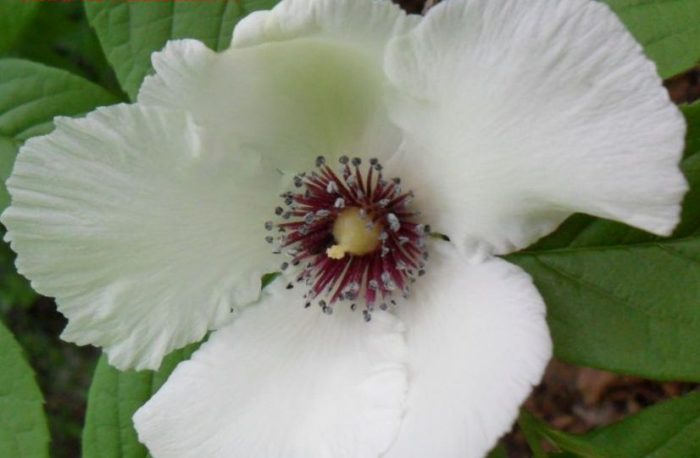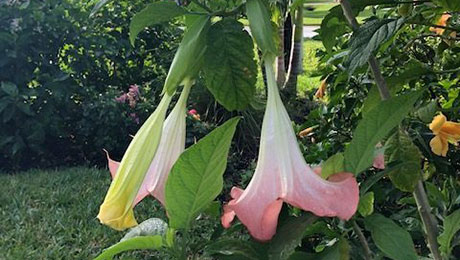
Mark Mitckes is a collector who likes rare plants and gardens in Zone 7a on a hill overlooking a lake in Oak Ridge, Tennessee. He has over 300 woody plants and at least as many perennials. He has been gardening for over 35 years and also has visited many gardens on his travels. His favorite area for buying plants is the Pacific Northwest coast, both in person and ordered off the internet. He has learned by experience that many of these plants will not survive his hot humid summers or cold wet winters.
 Sinocalycanthus chinense (Chinese sweetshrub, Zones 5–8). This beautiful shrub is the Asian equivalent of our native sweetshrub, Calycanthus floridus. It blooms in spring and early summer in the shade with these beautiful flowers.
Sinocalycanthus chinense (Chinese sweetshrub, Zones 5–8). This beautiful shrub is the Asian equivalent of our native sweetshrub, Calycanthus floridus. It blooms in spring and early summer in the shade with these beautiful flowers.
 Cephlathus occidentallis (buttonbush, Zones 5–9). This native shrub, which produces these unusual balls of flowers in summer, thrives in light shade and moist soils.
Cephlathus occidentallis (buttonbush, Zones 5–9). This native shrub, which produces these unusual balls of flowers in summer, thrives in light shade and moist soils.
 The unusual Gloriosa superba (gloriosa lily, Zones 8–11) is a scrambling vine, and it produces these glorious flowers in summer. Though not hardy over winter north of Zone 8, this plant does produce bulbous roots that can be dug and stored over winter like a dahlia or gladiolus for replanting next year.
The unusual Gloriosa superba (gloriosa lily, Zones 8–11) is a scrambling vine, and it produces these glorious flowers in summer. Though not hardy over winter north of Zone 8, this plant does produce bulbous roots that can be dug and stored over winter like a dahlia or gladiolus for replanting next year.






Have a garden you’d like to share?
Have photos to share? We’d love to see your garden, a particular collection of plants you love, or a wonderful garden you had the chance to visit!
To submit, send 5-10 photos to GPOD@finegardening.com along with some information about the plants in the pictures and where you took the photos. We’d love to hear where you are located, how long you’ve been gardening, successes you are proud of, failures you learned from, hopes for the future, favorite plants, or funny stories from your garden.
If you want to send photos in separate emails to the GPOD email box that is just fine.
Have a mobile phone? Tag your photos on Facebook, Instagram or Twitter with #FineGardening!
You don’t have to be a professional garden photographer – check out our garden photography tips!
Do you receive the GPOD by email yet? Sign up here.
Fine Gardening Recommended Products

Pruning Simplified: A Step-by-Step Guide to 50 Popular Trees and Shrubs
Fine Gardening receives a commission for items purchased through links on this site, including Amazon Associates and other affiliate advertising programs.

The Nature of Oaks: The Rich Ecology of Our Most Essential Native Trees
Fine Gardening receives a commission for items purchased through links on this site, including Amazon Associates and other affiliate advertising programs.

Planting in a Post-Wild World: Designing Plant Communities for Resilient Landscapes
Fine Gardening receives a commission for items purchased through links on this site, including Amazon Associates and other affiliate advertising programs.


















Comments
Hi, Mark, I'm a fellow east TN gardener (Friendsville...a bit south of Oak Ridge). Anyway, your collection of exotic beauties is quite eye opening and impressive. I'm especially intrigued by the flamboyant Gloriosa superba and the Scadoxius puniceus which looks like a burst of fireworks. You must have a very disciplined work ethic of digging up and wintering over the various bulbs and bulbous roots that produce the special plants that give your garden such an exotic flare. Thanks for sharing.
Love you ‘Little Honey’. I have searched & searched for it this past year but the one place I found it was out of stock :( . All so lovely!
Stunning collection. I have a friend who has gifted me with some of his collection. He like you, has been at it for decades. He is a very special person as I suspect you are. I appreciate you sharing & am awaiting your next post !!!
Gorgeous!! That gloriosa lily certainly earns its name!
Such unusual and interesting garden choices you have there... That Jack in the Pulpit has my attention and I could grow that in my zone 6b garden! Thanks for the inspiration!
There is a generally accepted opinion that irises need to be divided and transplanted immediately after flowering, so that they can be taken before winter. But if in your area the autumn is warm and long, you can take your time with the transplant. In fact, irises can be planted in spring, and autumn, and in summer after flowering. The main thing is not to forget to transplant irises every 3-4 years, and Siberian irises - at least once every ten years, otherwise they degenerate, grow and cease to bloom
Log in or create an account to post a comment.
Sign up Log in